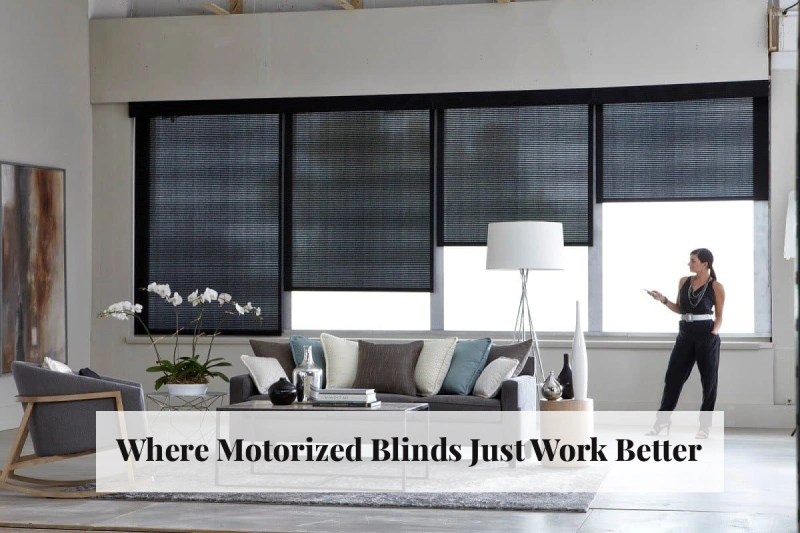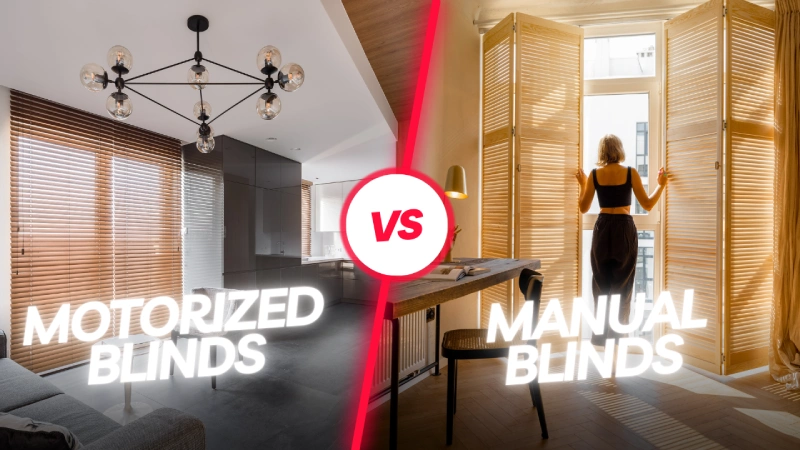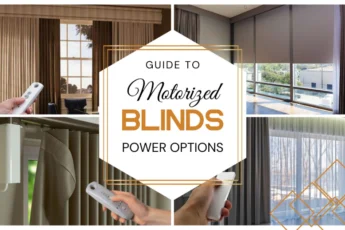Most people don’t think too much about the blinds. Just something for the window, right? But in Abu Dhabi, where the sun doesn’t go easy and rooms heat up fast, you need blinds that do more than just cover glass. It’s not only about how they look, it’s more about how they work day to day, keeping light out and heat low.
So when it’s time to decide between motorized and manual blinds, the choice might seem simple. But it isn’t. It depends on what your space needs, what your routine looks like, and where those windows actually sit.
What Separates the Two?
Manual blinds don’t have motors. You pull a cord, twist a rod, or shift them by hand. It’s the old way, and it still works in a lot of places. Motorized blinds, on the other hand, move on their own using a remote control, wall switch, app, or voice; whatever setup you’ve got. Some even follow a schedule, adjusting by time or sunlight. It’s like less touching, more ease.
So, what’s the reason for making a choice? You have to define the interior aesthetics, opt for functionality that you like, limit the budget (of course), and more.
Where Motorized Blinds Just Work Better
Some windows just aren’t made for hand-pulling. A tall one over the kitchen sink? Not the kind you want to mess with during cooking. That’s where motorized blinds just make more sense, as they handle those tricky spots without you stretching or spilling something.

The same goes for large living room windows or high glass panels. You don’t want to be climbing chairs to fix a crooked blind. And for families who like smart setups such as lights on a timer, AC linked to apps, blinds that open and close on their own, just fit right in.
Manual Blinds Still Have a Role
But not every space needs all that. For guest rooms, storage, and bathrooms, the manual does the job just fine. You open them in the morning, shut them before bed, and that’s it. Nothing fancy, no charging, no tech to worry about.
They’re also lighter on the pocket and the perfect of its kind for renters, folks not staying long, or those who prefer to keep things simple. And if something breaks? It’s usually a string or bracket, not a motor. So, the damage repair is simple, economical, and efficient.
What About the Cost?
Motorized window blinds, of course, are a bit of a strain on the wallet. They do cost more at the start, yeah. That’s because you’re not just paying for the blinds, but also the little motor inside, remote stuff, maybe someone to come fit them. It depends on how big the window is or what brand you pick. The prices vary, and you should get a quotation beforehand.
Manual blinds? You can get a whole set for the price of one motorized window. Even if you go custom, they’re still easier on the wallet. But most people consider motorized blinds pay off long run. You get to enjoy many benefits like less wear, longer lifespan, and energy savings if they’re set right.
Installation—Which Is Simpler?
Put up manual blinds? It’s not too hard, and you just need a few screws, a drill, maybe one extra hand, and it’s up. It doesn’t take much skill, just a bit of care and time. Motorized ones can go two ways. Battery-powered types are still easy.

You just have to clip in, sync with the remote, and be done. But if you’re going for wired, things get trickier. You might need to run cables or plan sockets nearby. Easier during home builds or renos, but not as plug-and-play.
Any Difference in Look? Aesthetics Matter!
Whether you go with motor or hand-pull, you still get choices, including wood-look ones, PVC, even fabric, etc. They don’t look that different unless you peek behind at how they move. One-edge motorized blinds have no cords dangling. Neat, especially if you’ve got kids or pets around. Some people like that clean, tidy finish.
What About The Energy and Efficiency Angle?
Motorized blinds do help with energy if you use them smartly. You can program them to block midday sun and open them at sunset. That cuts down AC use, keeps rooms cooler without more electricity.
Manual blinds work if someone remembers to close them. If not, heat builds up. Lights stay on longer. AC runs more. So, if you’re the forgetful type or just too busy to run to windows often, automation helps.
What About Fixes and Upkeep?
Manual blinds usually just need a look-over now and then. If the cord frays or the slats twist, it’s fixable fast. No need to mention that the hardware is common and easily available offline and online. Plus, the repairs don’t cost much.
Motorized ones don’t need much either, but when they do, it’s not always a DIY job. The battery needs to be charged, and the motor could get stuck. You might need brand support, which takes longer.
What Suits Which Room?
Motorized Blinds Work Best For:
- Tall or wide windows
- Kitchens with unreachable window areas
- Living rooms with daily light control
- Smart homes or tech-heavy setups
Manual Blinds Make Sense In:
- Guest bedrooms
- Small shaded spaces
- Apartments or rentals
- Homes with basic needs
Final Verdict about Motorized vs. Manual Blinds
It’s about how you live. If you like automation, want less hassle, and have rooms with tough-to-reach windows, motorized blinds are worth it. They do more with less effort, and in Abu Dhabi’s sun-heavy climate, they can even help lower indoor heat.
But if you just want something that works, won’t cost too much, and you don’t mind doing things yourself, manual blinds are still solid. They’ve been around this long for a reason. At the end of it, blinds should fit your lifestyle, not just your wall.
Also Read this: Home Decor Renovation: Modern Bedroom Design Ideas To Inspire You





Leave a Comment